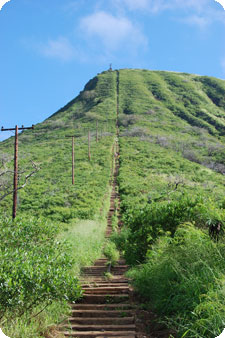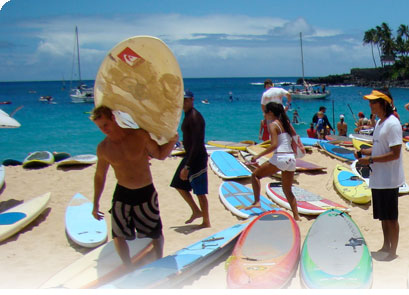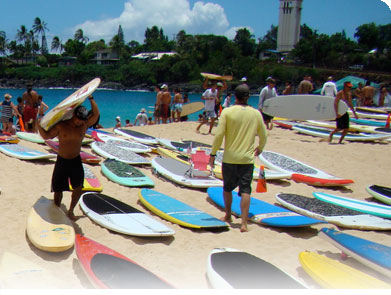above: Hui O He'e Nalu 4th of July Paddleboard Race at Waimea Bay

Koko Head Thigh Burner Workout |
 |
Talk Story
SUP VERSUS SWIMMING WORKOUT
By Morgan Hoesterey
One of the best things about standup paddling as a sport is the fact that you can choose what you want from it. The sport’s versatility allows people from all walks of life to participate. Lately, there seems to be two types of standup paddlers, the ones who surf, and the ones who don’t. The ones who don’t surf participate in order to utilize the workout potential of standup paddling. It provides a full body workout that is hard to match. In my opinion, there are few sports that exist that provide as comprehensive of a workout as paddling does. Swimming is one of those sports. Swimming is a lot like paddling in that, it works your whole body, focuses on your core and really strengthens your back and shoulders.
As a swimmer, I have spent the past 20 years following the black line on the bottom of the pool. As much fun as staring down at a stationary tile line is, following the lines of the ocean on a standup board is much more entertaining. The transition from swimming to standup paddling is an easy one. As swimmers, we tend to have the endurance it takes to make those downwind runs, or to get out to the outer reefs. In addition, swimmers are likely to have the strength it takes to be able to carry boards and handle the upwind paddles as well.
When I decided to make the transition from swimming to standup paddling, I realized that I could take what I had learned throughout my years of swimming training, and use them to become a better paddler. Swimming is a sport that is notorious for the amount of training time it takes to be successful. Likewise, in standup, the person who puts in the most time with the ocean ultimately will be the best paddler. At the end of the day, time in the water is what is going to make an athlete successful, however, I feel that cross training is important as well. Dry land training is an important part of swimming, not only because it helps you get stronger, but also because it helps break up the monotony of doing the same thing everyday, and gives your body a chance to use different muscle groups. Standup for me has never been as mundane as swimming could be, but it is nice to give your body a break from paddling for a day to utilize different muscles and give your paddling muscles a break.
The only part of standup paddling that following that black line didn’t prepare me for was the open ocean. Most competitive swimmers are used to the pool--a controlled environment that is always the same temperature, is a fixed length, has no waves to deal with, and offers no chance of being blown out to sea. Throughout my swimming career, I knew exactly how many strokes it would take to get from one side of the pool to the other, and that count was the same 99 percent of the time. The ocean is not that predictable. Every downwind run is different, every wave is different, and because swimmers are creatures of habit, the ocean’s ever-changing personality is not always the easiest thing for us to deal with.
In so many ways, my training as a swimmer prepared me for standup paddling. In hindsight, I wish that standup had been as big when I was training at the pool as it is now. I think that for swimmers, standup is a beneficial form of cross training, as well as a lateral move if you are a swimmer that is looking for an alternative way to exercise. Below are my comparison workouts for the two sports.
Swim schedule vs. Standup schedule
|
Swim |
Standup Paddle |
| Monday |
A.M. - Weights and pool workout
P.M. - Pool workout around 6000 meters |
A.M. - Some type of Cardio, either climbing Koko Head (a steep 600 foot climb) or a longer paddle
P.M. - Paddle as much as possible after work |
| Tuesday |
A.M. - Dry land training and pool workout |
A.M. - Hawaii Kai run (8-10 mile downwinder)
P.M. – Dry land training, beach workout |
| Wednesday |
A.M. - Weights and pool workout
P.M. - Pool workout around 6000 meters |
A.M. - Some type of Cardio, either climbing Koko Head or interval training
P.M. - Paddle as much as possible after work |
| Thursday |
A.M. - Dry land training |
A.M. - Hawaii Kai run, or paddle sprints
P.M. - Dry land training, beach workout |
| Friday |
A.M. - Weights and pool workout
P.M. - Pool workout around 6000 meters |
Off |
| Saturday |
A.M. - Pool workout, usually speed and race training |
|
Saturday and Sunday…tried to do longer runs, depending on whom I could get to go with me
The schedules aren’t exactly the same, but the structure was fairly similar… |

